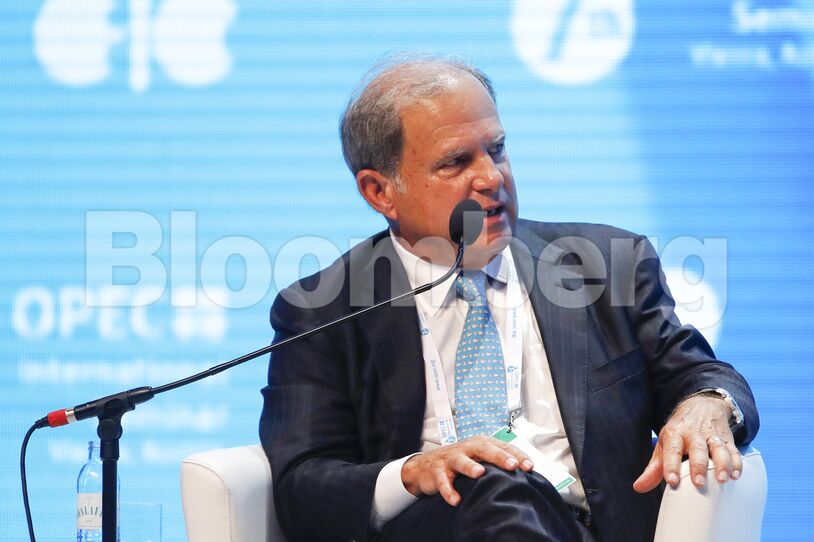By Kevin Crowley, David Wethe and Sheela Tobben
“In the future, certainly we believe OPEC will be the swing producer — really, totally in control of oil prices,” Bill Thomas, chief executive officer of EOG Resources Inc., the biggest independent shale producer by market value, said earlier this month. “We don’t want to put OPEC in a situation where they feel threatened, like we’re taking market share while they’re propping up oil prices.”
The shale industry’s prudence, also echoed by the CEOs of Pioneer Natural Resources Co. and Occidental Petroleum Corp., means that production will probably flatten after a steep plunge this year. U.S. oil output will end 2021 close to 11 million barrels a day, about the same as it is now, according to forecasters IHS Markit, Rystad Energy, Enverus and the U.S. Energy Information Administration.
“I see no more growth until 2022, 2023, and it will be very, very light in regard to the U.S. shale industry ever growing again,” Pioneer CEO Scott Sheffield, who’ll run the fourth-largest shale operation in the country after his company completes the takeover of Parsley Energy Inc., said in an interview.
That will surely come as a relief to OPEC and its allies.
At the start of 2020, the group’s efforts to control prices were facing increasing difficulties. The breakthroughs in horizontal drilling and fracking that ushered in the shale revolution made it look as though U.S. production growth might never end. Output surpassed 13 million barrels a day for the first time in February.
Then Covid-19 hit, people around the world stopped driving and flying, and the oil market crashed. President Donald Trump brokered a historic deal with OPEC in April to remove almost a 10th of global production from the market. He said the U.S. contribution would come in the form of market-driven cuts.
That pledge was delivered faster than most predicted, and it made a huge difference. Investors who were already tiring of the shale industry’s cash-burning spree retreated from the sector, and several producers went bankrupt. Before the summer was over, U.S. output had collapsed by 3.4 million barrels a day, almost the same as removing the United Arab Emirates at peak production.
Output from shale wells typically declines in a matter of months, so new ones need to be drilled and fracked just to maintain production at current levels. A recent uptick in drilling and fracking doesn’t seem to be enough to ensure production growth.
Since hitting bottom in the summer, the number of rigs searching for crude in shale fields has increased by 69 to 241 this week, according to data from Baker Hughes Co. That’s still down from 683 in March.
Similarly, the number of fracking crews in the once vibrant Permian Basin straddling Texas and New Mexico has increased to 63, an improvement from a meager 20 in June, data from Primary Vision Inc. show. But that’s less than half the 146 teams that were pumping mixtures of water, chemicals and sand into wells in January to release oil from shale rock in the area.
It’s as though the U.S. suddenly went from being a thorn in OPEC’s side to being an unofficial member of the cartel’s alliance with Russia and other producing nations. Since June, benchmark U.S. oil prices have been remarkably stable, hovering around $40 a barrel, and that’s how OPEC likes it.
Now, when the cartel meets in a virtual gathering Nov. 30, and the broader OPEC+ alliance on Dec. 1, they’ll probably be more focused on the pandemic’s impact on fuel consumption. Most of the crude the group removed from the market has already been successfully brought back without any turmoil.
While shale’s retreat has made OPEC’s life easier, for the U.S. oil industry it’s been brutal. There have been 43 bankruptcies of exploration and production companies this year through October, according to a report from law firm Haynes & Boone.
Shale may be down but it’s certainly not out, though. The U.S. is still an oil superpower, and will remain so for years to come. And there’s always the possibility that higher prices will get explorers drilling and fracking relentlessly like before.
A sustained price rise to $50 a barrel will “trigger growth again,” according to Bernadette Johnson, vice president for strategy and analytics at Enverus. At $60 a barrel, U.S. shale will come back strongly, she said.
The oil market received a boost this week as AstraZeneca Plc became the third drug company to show promising results from a trial of its coronavirus vaccine. That helped push prices in New York above $45 a barrel for the first time since March. If other pieces of bullish news take prices to levels that would encourage growth in shale, even if temporarily, producers could seize the opportunity to lock in prices with hedging contracts. That’s a risk OPEC+ will have to consider.
Whether investors will be willing to bankroll shale anew is another question. Before Covid-19, the industry was already buckling under high debts and shareholder discontent. Shale producers burned through about $342 billion of cash since 2010, Deloitte LLP said in June.
Another unknown is what titans Exxon Mobil Corp. and Chevron Corp. will choose to do next year. Both slashed capital budgets by around a third this year, with the biggest cuts coming from U.S. shale.
“Crucially, OPEC+ does not have to battle for market share just yet,’’ Natasha Kaneva, a commodities analyst at JPMorgan Chase & Co., said. “After six months of minimal capital spending, U.S. shale production will remain constrained.”
Share This:




 CDN NEWS |
CDN NEWS |  US NEWS
US NEWS 






























